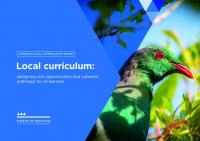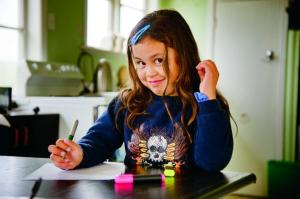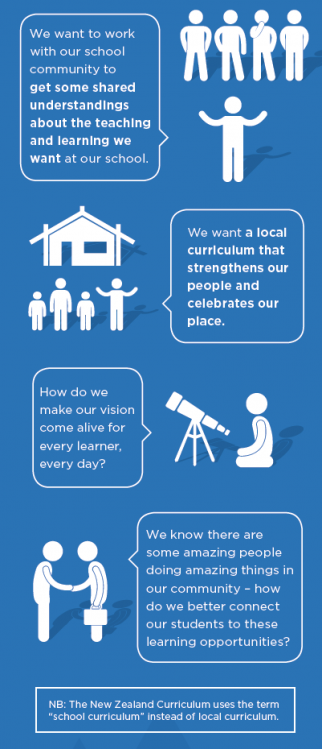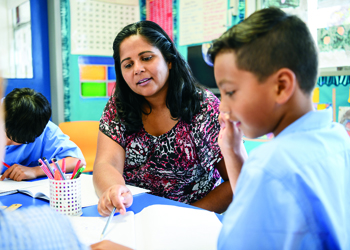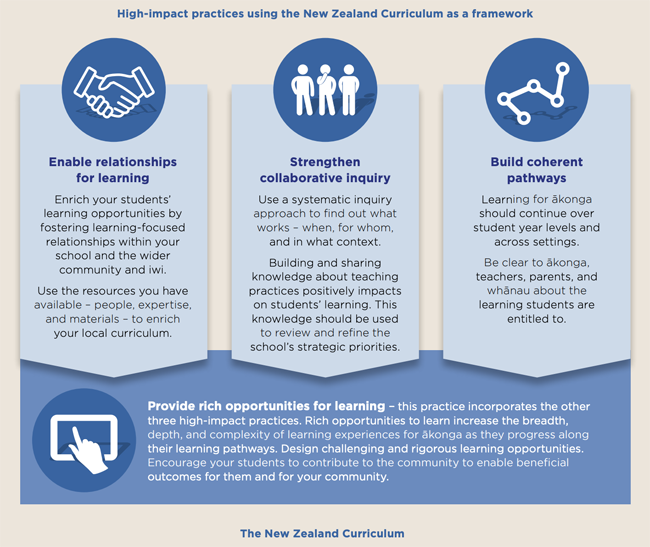What is a local curriculum?
High impact practices for designing a quality local curriculum
Using the high impact practices to design and review your local curriculum
This guide focuses on the key elements of designing and reviewing your local curriculum. It can also be used for ongoing review.
You can use it to lead conversations with:
- your staff, parents, whānau, hapū, iwi, and the wider community – to better understand the needs and interests of your students
- your staff – to talk about your school’s areas of strength and what can be improved.
It contains guidance, review questions, activities, examples, and resources that will help to enable good decision making as you design and review your local curriculum. The start of the year is a good time to begin conversations with your staff that can continue throughout the year.
Where can you get further support?
The guide series is part of a package, including workshops and tools that will support schools to develop and review local curriculum.
Email [email protected] or contact your local Ministry of Education office for further support and information.
Ko te manu e kai ana i te miro, nōna te ngahere Ko te manu e kai ana i te mātauranga, nōna te ao.
The bird that partakes of the miro berry owns the forest; the bird that partakes of education owns the world.
What is a local curriculum?
The New Zealand Curriculum is a clear statement of what we deem important in education. It takes as its starting point a vision of our young people as lifelong learners who are confident and creative, connected, and actively involved and includes a clear set of principles on which to base curriculum decision making.
See schematic view of the New Zealand Curriculum document.
Your local curriculum is the way that you bring The New Zealand Curriculum to life at your school. It should:
- be responsive to the needs, identity, language, culture, interests, strengths and aspirations of your learners and their families
- have a clear focus on what supports the progress of all learners
- integrate Te Tiriti o Waitangi into classroom learning
- help learners engage with the knowledge, values, and competencies so they can go on and be confident and connected lifelong learners.
Key points for designing and reviewing your local curriculum
It’s your school and it’s your curriculum
- Your local curriculum should be unique and responsive to the priorities, preferences, and issues of your community and your people.
- What is important is that all elements of The New Zealand Curriculum are used as the framework in designing your local curriculum. This ensures you’re supporting the strengths of all of your learners.
It’s an ongoing process
- At the heart of local curriculum design is including what works and improving learning for all students.
- You may not find what works best straight away, or for all of your students. Understanding that it’s a journey means you can continue to challenge and evaluate your ideas, systems, and processes.
What does good look like?
A school’s curriculum is likely to be well designed when:
- principals and teachers, with the community, can show what it is that they want their students to learn and how their curriculum is designed to achieve this
- learning is personalised and inclusive to take into account the students' aspirations, interests, identity, language, and culture
- the long view is taken: each student’s ultimate learning success is more important than the covering of particular achievement objectives
- it is manageable and realistic.
“You can’t just pick up what another schools’s done. There’s no recipe. What you might do will be different to us because of your community, your students, your location. The process of giving effect to the national curriculum is about making it work in your school.”
Principal
“The best thing we did was not say, “We’re finished”, as different aspects of practice were reviewed. Staff now see constantly evolving approaches as a hallmark of educational practice.”
Associate Principal
Return to top
High impact practices for designing a quality local curriculum
It can be difficult to know where to focus your attention when designing or reviewing your local curriculum.
These four high impact practices, taken from the Local Curriculum Design Toolkit, give you some ways to strengthen your local curriculum.
Important things to note
- Just get started – reviewing one part of the curriculum inevitably leads to thinking about the other parts.
- There is no single way to review a curriculum or assessment practices.
- Time is a significant consideration – it takes time for teachers to understand the need for change and to adapt their practices.
- Curriculum design and review is complex – you won’t necessarily find what works best right away.
- Embed small changes and then build on them.
High impact practices using The New Zealand Curriculum as a framework
Return to top
Using the high impact practices to design and review your local curriculum
We will now explore the high impact practices in more detail – Enabling relationships for learning, Building coherent pathways, and Providing rich opportunities for learning.
For more information on "Strengthening collaborative inquiry", please see the Local Curriculum Design Toolkit.
Understanding The New Zealand Curriculum
Your local curriculum needs to reflect the intentions of The New Zealand Curriculum (NZC). The NZC vision, principles, values, key competencies, and learning areas need to be expressed in your local curriculum in ways that build on the strengths and meet the aspirations of your learners, their families and whānau.
Think about these questions as you lead your review
- How do we ensure that the full extent of The New Zealand Curriculum is expressed in our local curriculum?
- How do we integrate Te Tiriti o Waitangi into classroom learning?
- How do we give all our learners rich opportunities for learning across the curriculum?
- How do we demonstrate clear pathways to learning across the learning areas and the curriculum levels?
- How do we integrate the principles, values, key competencies, and learning areas in our classroom programmes?
- Are we up to speed with the revised technology learning area and the new digital technologies curriculum content?
Review your local curriculum plan
Review the ways your local curriculum plan integrates The New Zealand Curriculum and creates rich opportunities for all of your students. Look out for:
- the NZC principles
- the NZC values
- key competencies
- learning areas and progression in these areas (including the digital technologies curriculum content)
- effective pedagogy.
Strengthen your local curriculum plan
- Analyse the aspects in your plan, look at what is being well integrated and where there is more potential for rich learning.
- Compare with other plans across the school.
- Discuss how the NZC aspects have been deliberately integrated into these plans to identify the school's shared views and priorities.
- Discuss how you will activate this plan.
Example of integrating a local curriculum with the NZC
ERO – Focusing on the school's and national curriculum priorities
Leaders and teachers at Oratia School carefully integrated all parts of The New Zealand Curriculum with their own local values, while prioritising the principles or key competencies that delivered the most benefit to their children. From Keeping children engaged and achieving through rich curriculum inquiries (ERO, 2018)
Further resources for guidance
Enable relationships for learning
To enable relationships for learning across the community, it is important to seek input from students, parents, whānau, iwi and hapū as you shape your local curriculum. This ensures that the interests and needs of learners, the values and aspirations of parents and whānau, and the ideas and resources of the wider community influence decision-making around teaching and learning. One way to start is to review the relationships you have and identify which ones are critical to the success of your local curriculum.
Think about these questions as you lead your review
- How do we build partnerships with parents, whānau, iwi and hapū, and the wider community?
- How do we ensure that everyone in our community feels a sense of ownership for our local curriculum?
- How do we ensure that we are being inclusive and culturally responsive to our students, parents and whānau?
- How do we make use of local and community resources and connections? Examples of this are cultural connections, businesses, community resources, professional relationships, and service providers.
Review your relationships
- Consider ways that you currently partner with your parents and whānau. How could you get to know your community better?
Create a physical map of community resources
Use colour-coded flags or markers to identify different types of resources within your community.
- Which teachers use each resource/have contact with the resource? For example, a local conservation person.
- What year levels use the resource and why?
- Are there resources that you think are critical to the success of teaching and learning at your school – who do you need to be in contact with?
- Are there resources that are over-utilised in ways that don’t enhance learning?
- Identify topics to be taught this term which could be enhanced through local connections. Make a database of topics and possible connections and allocate staff to investigate.
Example of how school staff reflect their vision and work with community resources
Te Akau ki Papamoa School – Cultural inclusiveness
Staff at Te Akau ki Papamoa School place a strong emphasis on relationships between whānau, learners, staff, and their community. Their vision of "leading me to lead my learning" challenges students to take responsibility for their lifelong learning journey. Meanwhile, a philosophy of "know me before you teach me" inspires teachers to create a positive learning environment where all learners can celebrate success. The vision statement of Te Akau ki Papamoa School is illustrated in a mural that strongly reflects the school’s value of te reo Māori and tikanga Māori.
Further resources for guidance
Build coherent pathways
A local curriculum can enrich learning opportunities by ensuring coherence and continuity of progress for ākonga, both over the years and across settings, preparing them for lifelong learning. It can be used to describe the most important learning your community believes is too important to leave to chance, and can specify what this learning looks like at critical points.
Teachers can use the description of the most important learning to design rich opportunities for students to develop their conceptual understandings, competencies, and skills.
Think about these questions as you lead your review
- How do we use our vision to create coherent learning pathways?
- How do we ensure our school is ready to provide rich learning for all learners who arrive?
- How do we know we have prepared all of our students for their next learning step as they transition from our school?
What’s valued by communities is often described in school visions. Using a school vision to identify the most important learning is one way to guide the development of a coherent pathway.
Present your school vision to your staff
- Discuss what the most important learning would be for a young person to "aspire to" this vision. Be as specific as you can. For example, have you considered the learning areas, key competencies, literacy/numeracy, knowledge and skills?
- What values underpin the vision?
Explore what the most important learning associated with the school vision
What could it look like for different year levels and/or learning area groups?
- Ask the teachers responsible for each grouping (for example, year levels or learning areas) to describe what the most important learning looks like in the curriculum now for their area.
- Capture this information so that it can be shared for everyone to see (digitally or on paper).
- Use that feedback to look across the different year levels and/or learning area groupings. Consider how a student would experience a broad, rich curriculum – is the development and progression clear?
- If there are gaps or irregularities, look at the other year levels or learning areas to help create consistency and coherence in the language that you use. Your aim will be to get coherence across your setting.
- Check that this term’s planning incorporates the aspects of the most important learning and link back to the school’s vision.
Example looking at monitoring children’s development in the key competencies to better understand progression
Monitoring the key competencies at Sylvia Park School
Leaders and teachers at Sylvia Park School looked at the ways they were monitoring the key competencies and understanding student progression – trying different strategies until they found a right fit for their students. This example prompts questions to reflect on such as "How could you involve your students when assessing key competencies?"
Further resources for guidance
Provide rich opportunities for learning
In order to provide your students with rich opportunities for learning, you need to know your learners – their strengths, identities, needs, and aspirations. This involves finding out as much as you can about them, listening to their voices and consulting with their parents and whānau. Once you know your learners you can then begin a deeper inquiry into the rich learning opportunities you are providing and possible areas for change.
Think about these questions as you lead your review
- How do we know what the strengths, identities, needs, and aspirations are for our learners for the year ahead?
- How can we provide rich opportunities for learning based on our learners’ strengths, identities, needs, and aspirations?
- What knowledge and skills do we need and what actions should we take to help all our learners grow?
Students’ strengths and aspirations
At the beginning of a school year teachers often talk with students and their whānau about their goals, interests, and aspirations. Use that feedback in groups to discuss what you know about your students’ interests and aspirations. Make sure there’s enough information about all of your students and whether there are ways you can find out more about what their interests and ambitions are.
- What are some common goals and aspirations?
- What are some outlier interests (maybe only one or two students)?
- How can these interests be incorporated in this term’s teaching and learning? For example, are there students who can lead/teach and provide opportunities for other students to learn?
- Are there opportunities for students to extend their expertise in their areas of interests?
Example of how Papatoetoe North School designed a curriculum that connects their students’ lives
ERO – Using a spiral curriculum to build on children's prior knowledge
Leaders, teachers, and parents at Papatoetoe North School have designed a responsive curriculum that connects to students’ lives and builds on their prior understandings, cultural identities, and out-of-school experiences. From Keeping children engaged and achieving through rich curriculum inquiries (ERO, 2018)
Further resources for guidance
Published on: 27 Nov 2019
Return to top

